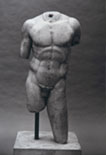
Unknown
Roman
Doryphoros, 440 BCE, ca.
marble
49 1/4 × 23 × 12 in.
SBMA, Gift of Wright S. Ludington
1955.3.1
COMMENTS
Roman copy (Hadrianic) of the Doryphoros [door IF or us] by Polykleitos
This exceptionally fine, more than life-size torso of an athlete is one of the best-preserved of the numerous Roman copies of the much-admired Doryphoros (Spear-bearer) by Polykleitos, that is, the specimen from Pompeii now in the Museo Nazionale at Naples. Though fragmentary, the Santa Barbara Doryphoros shows not only that quality of solidarity or “squareness” so often equated with Polykleitos’ Argive origin and characteristic of the so-called Peloponnesian school, but also the harmonious symmetry of design that Polykleitos perfected in his sculpture according to his canon on the proportions of male form. All the marble copies of Polykleitos’ original bronze Doryphoros show something of the “hardness” and surface character of the muscles.
The Doryphoros was evidently a particular favorite among the Romans, for there is a remarkably large number of copies, in varying states of preservation. A good deal of study has gone into the problem of dating these copies. The Santa Barbara Doryphoros, though easily enough identified, is not easily dated. On the evidence of the apparent faithfulness to the fifth-century Classical style and the highly polished surface of the marble, the torso may be appropriately attributed to the Hadrianic period (A.D. 117-138).
Polykleitos was active during the reign of Pericles. His contemporary rival was Phidias, who was put in charge of the artistic direction of Athens by his friend, the ruler Pericles. The design of the Parthenon frieze is attributed to Phidias.
Polykleitos had a studio with many artists under him. They specialized in statues of athletes as the Olympic Games were very popular. A wide range of subjects was made in bronze, ivory and gold of which none have survived. Polykleitos was supposed to have invented the standards of beauty resulting in an order, regularity, and repose. This system of proportions is known as the Canon:
1. The palm of the hand is 4 times the breadth of the finger.
2. The length of the foot is 4 times the breadth of the palm.
3. The breadth of the shoulders is 4 times the breadth of the palm.
4. The height of the figures is 7 times the length of the head.
Another interpretation of the Canon is:
1. The very square build, the heads are placid and stolid.
2. The way of stepping forward with one leg.
3. The anatomy is virtually perfect.
4. A new device of harmonious and rhythmical composition – the relaxed arm is on the side of the tense leg and vice versa, giving an equal measure of activity to both sides.
We can see that our torso is posed in the typical Polykleitan stance, with the weight of the body placed directly on the right leg allowing the freedom of movement to the left. The left hand, to balance the tenseness of the right side, held a spear which rested upon the shoulder, giving an equal measure of activity to both sides. Thus our athlete, the spear bearer or Doryphoros satisfies the Canon of Polykleitos.
The Canon of Polykleitos is also referred to as the Procrustean Canon in view of the legend of Procrustes. According to one version, Procrustes was an innkeeper in the neighborhood of Athens. His obsession was that everyone should be of the same height. He, therefore, fashioned an iron bed for his guests and if a person was too short, he stretched them to bed length; if too tall, he lopped off the superfluous leg length. It is said that Theseus finally rid the countryside of the monstrous Procrustes.
Website preparer: Richard Strauss, October, 2004
